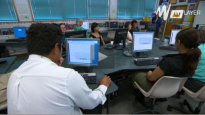You are here:
- Home >
- Pacific Education 2020–2030 >
- e-Learning and Pasifika
e-Learning and Pacific students
E tumau le fa’avae, ae fesuia’i le faiga
The foundations remain the same, but the ways of doing it change

The New Zealand Curriculum is focused on helping schools to be future focused, confident, connected, lifelong learners. In addition, the curriculum aims to create students who are digitally adept and globally connected.
With the growing number of schools investing in Innovative Learning Environments and Bring Your Own Device (BYOD), a digital pedagogy is another way to connect and create with Pacific learners.
e-Learning Planning Framework – helps schools and teachers reflect on, and evaluate, their e-learning capability.
Pacific culture, as well as e-Learning Planning Framework, emphasizes collaboration, creation, and sharing. Tools and technologies used in the classroom allow Pacific voices to be heard and shared in any language.
What follows are some ideas about planning, with Pacific learners in mind, an e-learning pedagogy.
How can e-learning make a difference for Pacific learners?
Successful learning for Pacific learners is founded on their languages, cultures, and values. It builds on what teachers know to be effective curriculum and pedagogy in the different cultural contexts with which learners from the Pacific Islands identify.
Technologies can make it easier for schools to provide relevant and meaningful connections to students’ communities and aiga (family), and provide learning experiences that are designed around culture, identified needs, strengths, and interests.
For Pacific learners, e-learning can offer ways to:
- engage with families and communities
- meet needs and draw on culture and language
- capture and reflect the homes and communities of learners
- build relationships between teachers and students
- personalise learning
- design learning that meets needs and builds on strength
- show you care about your students’ progress
- record, review, share, and clarify progress towards learning outcomes.
For more information about resources for and information about how to develop your e-learning practice, see Enabling e-Learning | Using digital technologies to support Pacific learners.
Reflective questions
In what ways does your e-learning pedagogy lift the chance of Pacific success?
How do you ensure that a student’s cultural identity is integrated into their digital world?
How are the tools and technologies used in your school creating meaningful connections:
- for students and their learning?
- between students and the global world?
- with the school community?
School stories
Examples of how schools are looking at e-learning with a Pacific lens.
Assessment and e-learning
An Auckland Girls Grammar School Samoan language teacher explains how she combines e-learning tools in her assessments so that her students to achieve to their potential. By using YouTube channels to film oral language assessments, the students can film their assessments without time pressure or time constraints.

Teaching Samoan via video conference
Lalaosalafai Tu’ua, who teaches at Southern Cross Campus in Mangere, describes his experience of using video conferencing to teach Samoan at NCEA level 3. He discusses the opportunities this technology provides for students who would otherwise be unable to access this learning.
Using ICT to enhance Samoan language
In this EDtalk, May Crichton discusses the process of used to create Samoan language learning resources that set out to support and extend children’s confidence with their language. Inherent in these resources is that both children and their families to speak Samoan at home.
Digi advisors and the Virtual Learning Network
A Pacific teacher shares his story about the benefits of being involved in both the Digi Advisor project and online communities of practice on the Virtual Learning Network.
Using video conferencing to expand learning options
Southern Cross Campus student, Shona Unasa, takes economics via video conference. She shares her learning experience using this medium.
Improving student writing with digital stories
Bridget Harrison's class at Kimi Ora Community School is made up of 100% Māori and Pacific students. In this clip she shares how they are using digital stories to scaffold the writing process. The success of this approach is reflected in their asTTle writing data.
Modern learning pedagogy through a Pasifika lens
In this EDtalk Anthony Faitaua discusses 21st century Pacific leaners with regards to learning pedagogy. He advocates creating a safe environment, understanding the students’ culture and values, and working with key influential community members in order to build vital learning relationships.
Using e-learning to engage family
Connecting with families and communities of Pacific learners
Using digital technologies, you can make powerful connections with Pacific learners, their aiga, kōpū tangata, whānau, families, and communities.
From e-portfolios to electronic newsletter to sharing and showcasing learning, schools facilitate a deeper engagement with aiga, kōpū tangata, whānau, and families – especially those who are not able to come into school.
Using technologies to connect with families may need some practical adjustments.
20/20 Trust
Provides Digital Inclusion leadership, research, and programmes. Digital Inclusion elements covered are access, skills, motivation, and trust.The trust partners with local communities to deliver Digital Inclusions programmes to school throughout Aotearoa New Zealand. Doing so allows families throughout the country to connect digitally and to get help with hardware and broadband access.
Parent technology sessions
Holy Cross School is a multicultural community. Kathy Moy-Low explains how the school staff has consulted with and engaged the parent community in e-learning.
One of the school's initiatives is after-school parent technology sessions, which are run once a month. In this video clip, parents explain why they go to the classes, the benefits of learning with technology, and how they will engage more with their children's learning.







